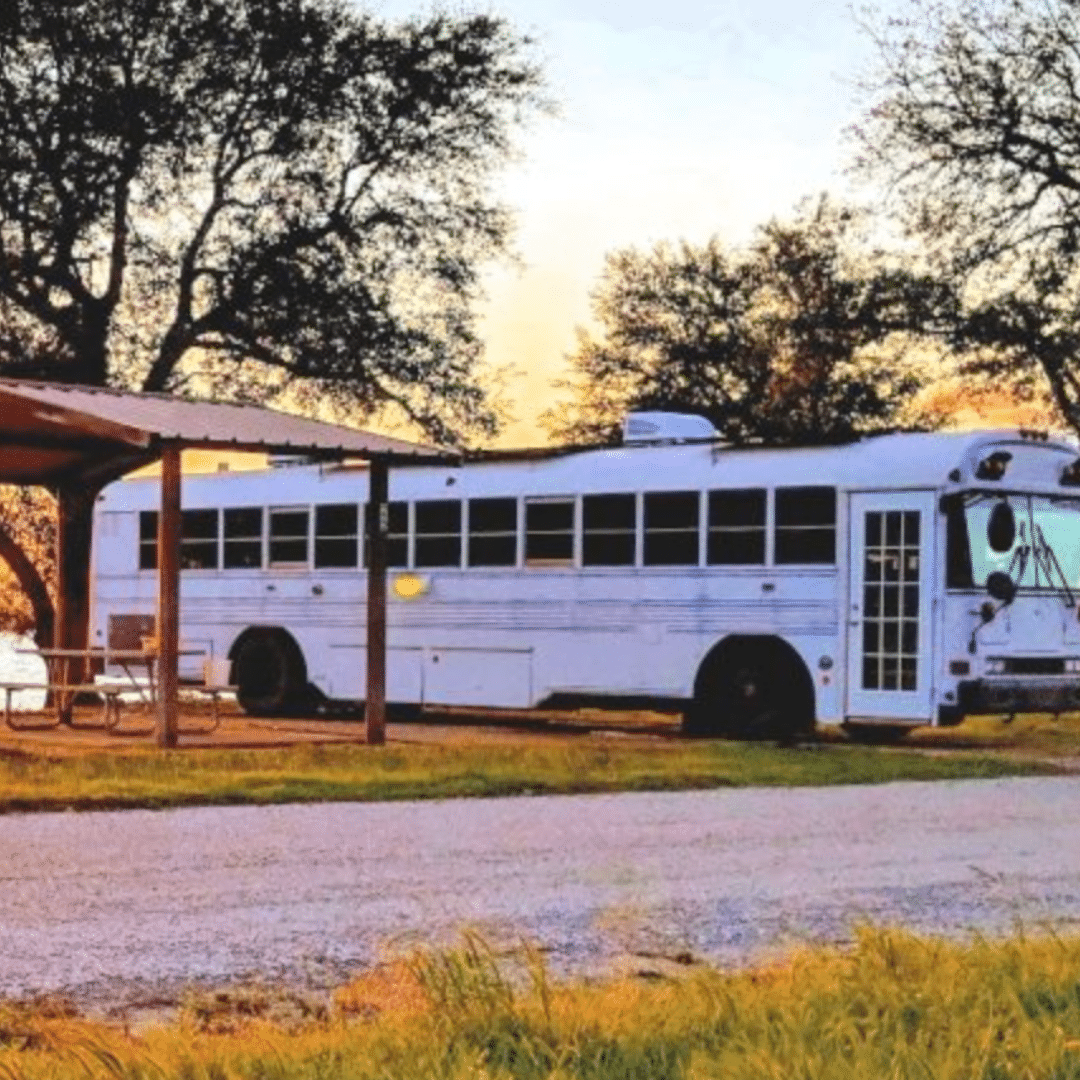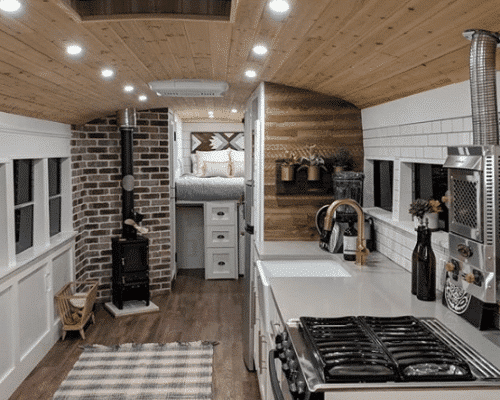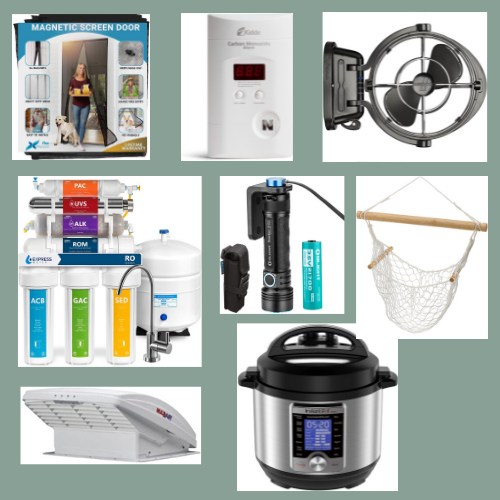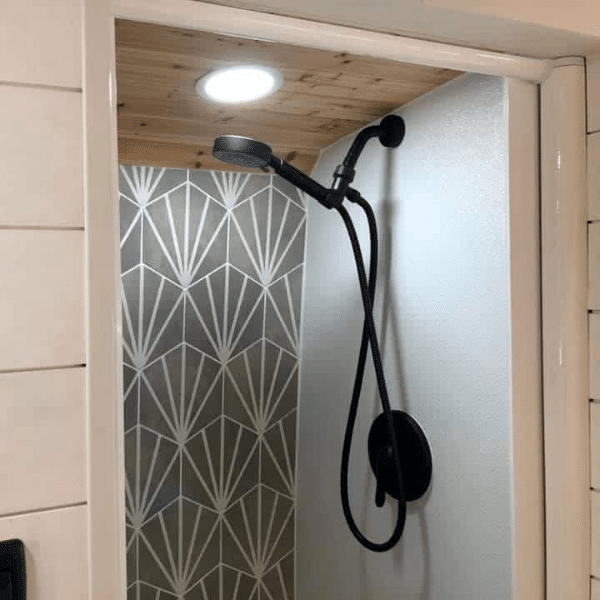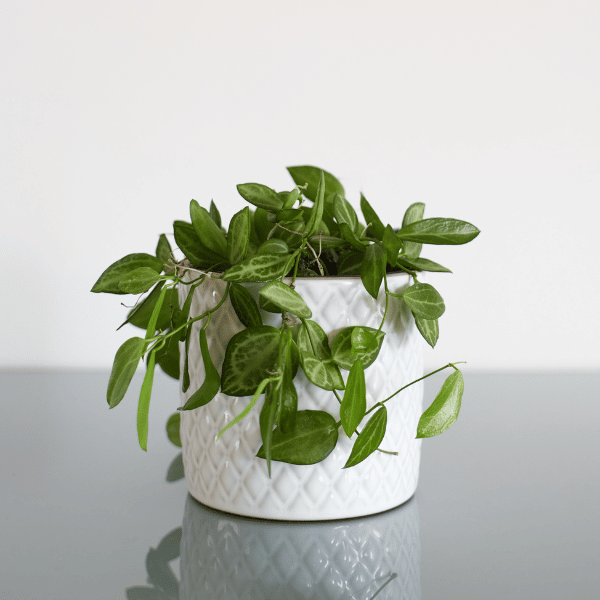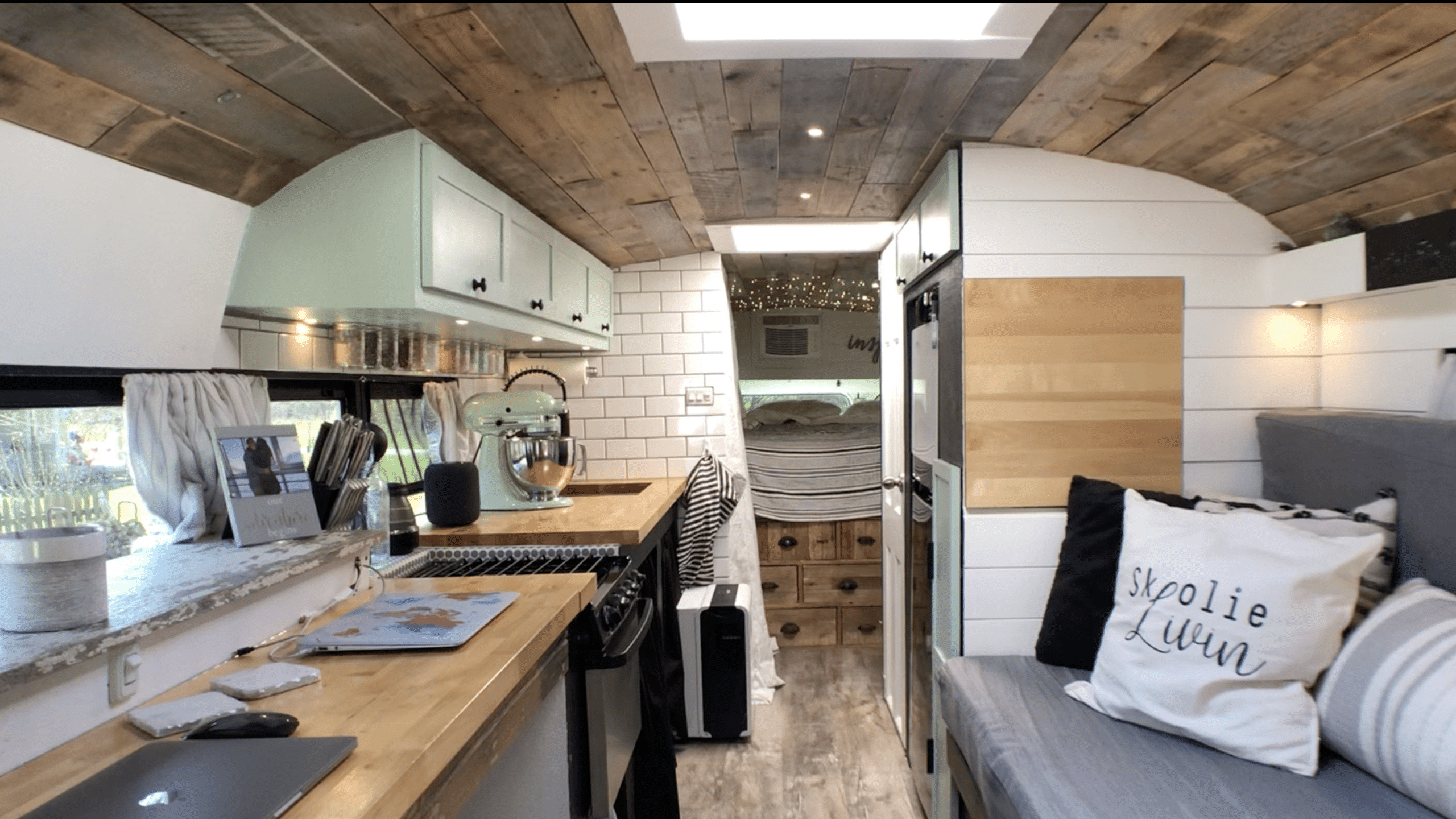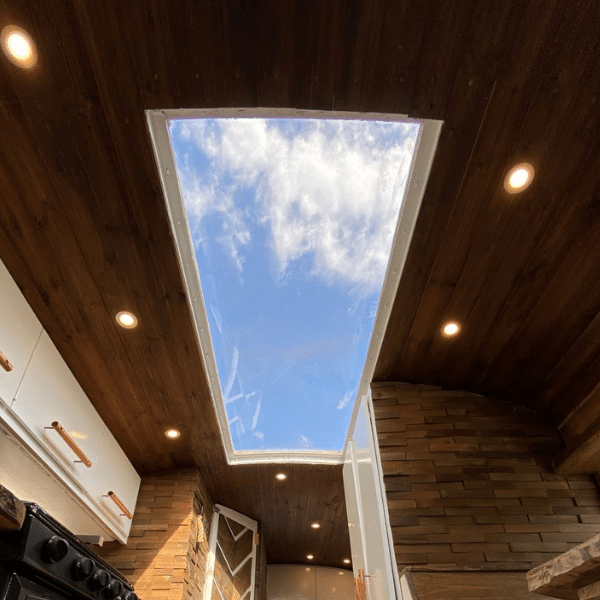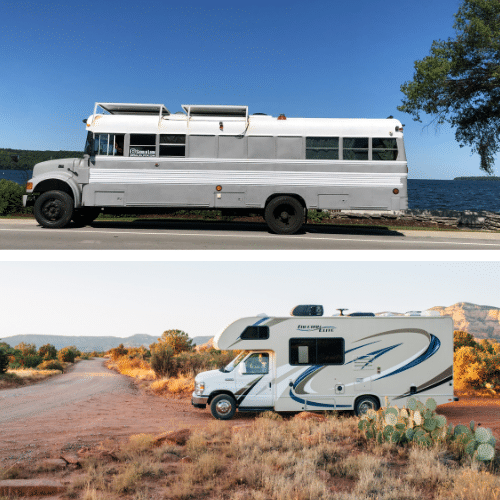
There are many differences between a skoolie vs RV. In this article, we will go over the pros and cons of a skoolie vs RV.
You have been probably considering doing a skoolie build, but want to make sure it is the right path compared to just buying an RV. Or, maybe you are looking up a resource to send to someone else questioning why you would go through all the work to build a skoolie.
The purpose of this guide is to help you understand the differences between buying an RV and building a skoolie so that you can see the pros and cons to make a decision of which path to go.
(Also, so you can send people a link to this article if they ask why you chose to build a skoolie over an RV.) 😉

Skoolie vs RV: Let Me Be Clear
First, I want to point out that there is a clear difference between an RV bought right from the dealer and someone who is buying a used RV to renovate into a custom build. Although some of the items in this article still apply to those renovated units, we are going to focus on someone purchasing an RV to someone who buys a raw bus and builds a custom skoolie.
I want to also take a minute to point out that I am in no way ragging about buying an RV. I think there is a definite place in the market for RVs. We do see the value in wanting to just buy a ready-to-use item for many people.
Both come with sacrifices.
Manufacturers, distributors, dealers, etc. all need to make a profit so you will often get lower quality than what you can do with the same money in a skoolie build.
However, in a skoolie build you will sacrifice a significant amount of time doing a DIY build or spend way more money than an RV if you hire out the labor.
There are definitely some people who should not be building skoolies and should just go buy an RV and get traveling right away – save the headache. However, there are many people who are crafty, love to learn, and want to take on the challenge of a skoolie build to have the added benefits of saving money and traveling in something they know every inch like the back of their hand.
To each their own. Our hope is to stay as unbiased as possible with this guide. As such, we will rag on the negatives and highlight the positives of each type of motorhome alike.
What is the Difference Between a Skoolie and an RV?
A skoolie is custom built from the layout down to the type of wood, screws, and paint to use allowing to select the quality and style of every detail. RVs are mass-produced at an assembly warehouse in only a few different configurations per model. There are also significant differences in cost, financing options, durability, and community.
One of the ways I like to explain the difference between a skoolie and an RV is this:
Skoolie’s are the Harley-Davidson of the motorhome world, whereas mass-produced RVs are more like Hondas.
Not into motorcycles?
Skoolie’s are the custom-built home by the owner, whereas mass-produced RVs are more like park model homes.
Don’t get me wrong – some RVs can be REALLY nice! And I mean better than some homes – at first.
Buy one of those and drive that thing around for a few years and you will be in the same situation as most of the used RVs you can tour at Camping World. The air vents are bent, walls delaminating, electrical issues due to issues in assembly that finally wiggles loose, a mattress that is now more like a smushed pancake, and a funky, musty smell that seems to linger… All on top of a 10 year loan you are still working to pay off.
With a skoolie, you can definitely have the same issues (or worse) depending on your craftsmanship if you are going the DIY route or the quality of the contractors you hire.
However, in most cases you can come out with a better quality motorhome for a fraction of the cost of a store/dealer bought RV that will last two to three times as long if done right.
However, a skoolie build is a PROJECT, which “project” is sort of an understatement. Our skoolie took about 2.5 years to get to where we felt somewhat “done” even though we still have projects. We have also redone most things 2-3 times, so there is some added cost and waste – but we still saved money on a much higher quality of build overall compared to buying something comparable.
With that brief overview out of the way, let’s dive deeper into the significant differences between a skoolie vs RV.
#1 Safety
There are certain regulations a school bus has to pass in order to manufacture them and there are also certain regulations an RV has to pass before manufacturing them. Let’s go through what each of these structures is made of.
School Buses:
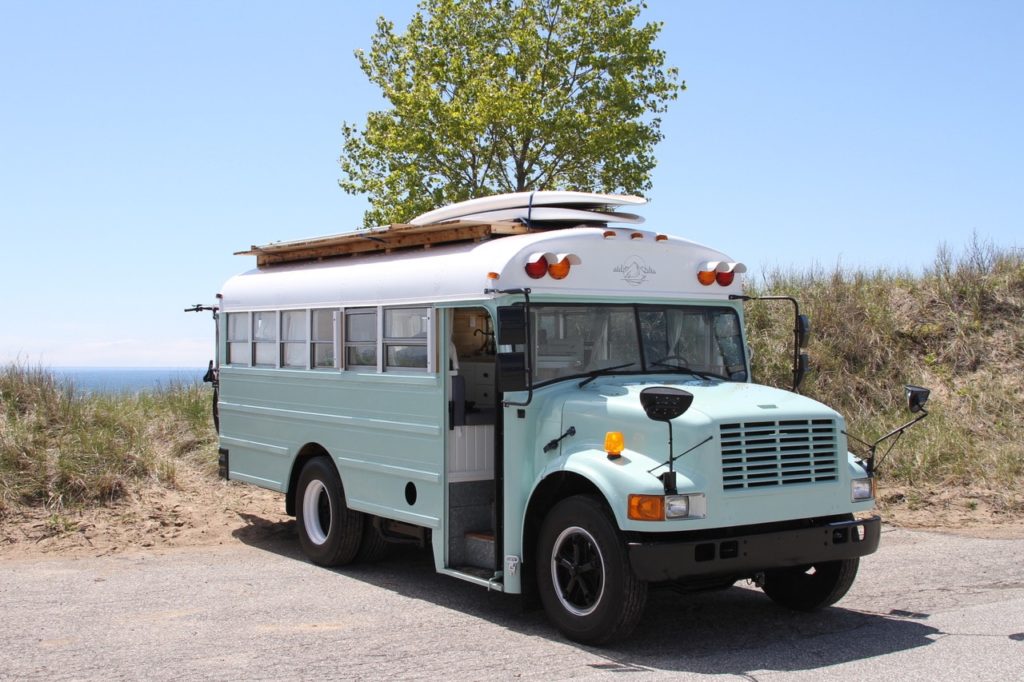
On a surface level, it seems school buses are made safe as they are made to safely carry children from point A to point B without seat belts. School buses are essentially built like roll cages this way. But what makes them so safe?
While there are many different types of school buses, school buses are made almost always the same, out of galvanized steel and molded steel hat channels. The molded steel hat channels then have another layer of galvanized steel on top of them, creating double thick steel walls and ceiling.
Having these hat channels every 28-32″ in the walls and along the ceiling mimics the features of a roll cage, making it very safe.
Did you know school buses are the most regulated vehicle on the road? So yes, school buses are literally designed to keep passengers safe. However, school buses are not made with airbags as the seats in them were made as “airbags” preventing passengers from flying forward in case of an accident. If you are thinking, well once you take the seats out, that changes the whole integrity of the bus, keep reading.
Remember that school buses are built like a roll cage in case an accident were to happen. But if you decide to convert a school bus, you must install seatbelts for everyone who will be traveling in it. Many people will mount seatbelts in the couch area and/or dinette area so others can travel safely when driving. Others even mount a van seat to the floor just behind the driver seat to make sure there’s seating with seat belts (especially for the kids). Just make sure you mount them to the ribs (hat channels) so the seat belts are sturdy and secure.
RVs:
As with skoolies, there are many different types of RVs. Depending on the RV class rating (A, B, or C) they may not even be needed to get checked for safety before manufacturing. Let’s dive into the different RV classes and the different safety features needed between them.
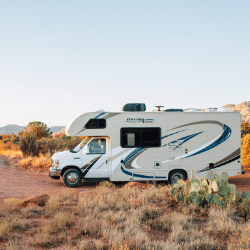
- Class As – Class A motorhomes are the large buses you see driving down the highway. In case of a collision, these have seat belts installed but no airbags. The driver and the passenger are also very close to the windshield and with you sitting in front of the front wheels, there isn’t much space between you and whatever you are getting into an accident with.
- Class Bs – These are the classic campervans and are generally the safest of the 3 different classes when it comes to being in an accident. These types of motorhomes have usually undergone what any other normal vehicle would undergo with safety measures and most likely come with airbags and definitely two seat belts for the front seats.
- Class Cs – You can think of class C motorhomes in a way that the front part is almost separate from the back part. The front part has been crashed tested and does include airbags. But if an accident is to occur, the back half could get totaled. To stay safe in class C RVs, make sure you are seated and buckled in when driving.
Safety is important to all of us. Whether you want a skoolie vs RV, safety is an important thing to think about. Always be sure to wear seatbelts and to have everyone stay seated when the vehicle is in motion.
If you are looking for something that is very safe, remember that school buses are the most regulated vehicle on the road.
#2 Community
A ton of people are living in RVs from military families to retired couples to families just looking to travel more. There are an estimated 25 million people traveling in RVs in the United States alone, which includes people traveling in school bus conversions.
In the past 4 years, skoolies have become increasingly popular and the industry has grown by over 400%. When we started our skoolie journey, there were a few people living in buses and it seemed as if there was such a community surrounded by it. We saw a lot of skoolie meetups from Skooliepalooza to Skoolie Swarm and much more. People coming together that share the same values of living with less and truly living. People have been living in buses since the 60s-70s, this definitely isn’t a new trend. But RV life also has a large community around it.
Whether you decide to convert a skoolie or buy an RV, there will definitely be a community that you will fit in with.
#3 Custom Built
With skoolies, you are essentially custom building everything! From the thickness and type of insulation you use to where you want natural light to the types of finishing materials used and even the paint colors.
With RVs, you are subject to what you are buying. What you see is what you get. This includes the kitchen cabinet colors, the countertops, the way the shower is done, the way the toilet is plumbed, but most importantly, the layout.
If you want a complete custom build and are DIY savvy, you would probably be more interested in a skoolie build. If you don’t mind about it being custom built and just want to hit the road, you may be happy with an RV.
Most people choose a skoolie to convert as a DIY project and to have it custom built to fit them and their families.
While ripping out and doing a DIY project here and there in an RV is certainly possible, it may still be more custom to do a skoolie build.
After thinking about this, let’s jump into the next comparison.
#4 DIY or Not?
This could arguably be the most important question. A skoolie build is not for the faint of heart. It requires a lot of hard work and determination. You are working with a rounded ceiling and bare metal, just a unique structure overall.
An RV is a lot simpler. You can simply go to a dealership and purchase it. They will give you a rundown of how everything works and you can get all your questions answered. They will usually help you if you run into any issues down the road, literally and figuratively.
You are simply on your own with a skoolie. If your electricity goes out, you have to problem solve and fix it. 90% of the time the skoolie owner does the electrical system (the other 10% being if you hire it out) and you have to know how it all works to diagnose problems down the road should you ever have to.
Ultimately, do you just want to get in and camp already? Or are you looking to test your skills, jump into a DIY project with determination to finish it, and then be able to enjoy your hard work?
#5 Full Time vs “Weekender”
Another big option to consider when choosing a skoolie or RV is how you want to be using the space. While I have mentioned you can get anything you want in a skoolie in the above comparisons, you are subject to what a manufacturer includes in an RV. Meaning the cabinetry selected, the type of shower they used, how much insulation is in the RV. All of these things you can’t control and you essentially get what you get.
This begs the question of will you be living in it full time or are you looking for a vehicle to get a few months road trip?
RVs are made more for the weekenders or part-timers, which is why they make the cabinets out of paper covered MDF or fiberboard. Since they make them for this reason, RVs are not meant to last forever, but if things do end up falling apart, you can always update and do some DIY projects!
Of course, like with houses or anything else, you will have to update things as they need it, yes even skoolies! But building it the way you want and choosing the best materials will help to make it last longer, which is perfect for full-time living.
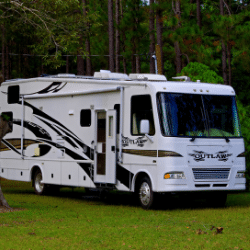
#6 Storage Space
There are tons and tons of storage space ideas for skoolies. Check out our post here about interior skoolie storage ideas.
If you are looking to live in it full time, space is valuable real estate. You can’t afford to waste much space without utilizing it uniquely somehow, especially when living in it full time.
RVs usually utilize a good amount of space, including outdoor underneath storage space as well as a nice closet space. But there are a lot of spots that could be utilized for storage that are not in RVs, like underneath the dinette seats and underneath the bed.
With a skoolie you can make almost any spot a good storage space. Common storage space savers are under couch storage, under bed storage, floor storage, tons of kitchen storage, front dash storage, and any bathroom storage you can sneak in.
Do you want a couple good storage options? Then you may be fine with an RV. Do you want every storage option to be custom built and really outfit with your own style? If yes, then a skoolie may be the one to choose.
#7 Off Grid vs On Grid
The electrical system is another big debate on skoolie vs RV in terms of do you want to be able to go off grid?
RVs are made to be plugged into the grid in order to use anything in the RV, like the air conditioner, fireplace, or TV. All of these things draw a lot of power. In order to run these, the RV needs to be plugged into the grid. RVs usually come with somewhere between 80-200 amp hours in their batteries. A typical battery in an RV is a lead-acid battery. Lead-acid batteries should only discharge half of their amp hours to keep the battery in top shape. If you discharge a lead-acid battery more than 50% of its capacity, the battery life will greatly decrease. This means RVs come with 40-100 amp hours of usable power. That is not a lot of juice, so you will be dependent on plugging into the grid when buying an RV.
Skoolies owners typically build out their bus to be fully off-grid because that’s what most people want to use it for, and be able to park on BLM land for as long as possible. An average battery capacity for a skoolie owner is 200-800 amp hours with 300-400 amp hours being most common. Most skoolie owners invest in lithium (LiFePO4) batteries. With lithium batteries, you can discharge them 90-100% so you get to use all of the amp hours, unlike using only half with lead-acid.
With having around 300-400 amp hours and solar panels to charge your batteries, skoolies can live completely off-grid for an indefinite amount of time.
#8 Black Water vs Grey Water
Another big debate when choosing a skoolie vs RV is the toilet and plumbing situation. Black water is defined as waste water from toilets that contains human waste. Grey water is defined as relatively clean waste water from baths and sinks.
With skoolies, there are multiple different options for toilets. Read our skoolie toilet options article here. The most popular option is a composting toilet for skoolie owners. This leaves you with a self-contained toilet and therefore, a grey water tank only.
With RVs, a toilet is already installed so this leaves you carrying around a black water tank. Some RVs come with a black water tank (toilet) and grey water tank (shower and sink). Black water tanks require a bit more maintenance and have to be emptied carefully at sanitary dump stations.
Before choosing a skoolie or RV, think about the life you want to live with the skoolie or RV and how many times you really want to be emptying your black/grey tanks. You will want to be emptying a black water tank a lot more than a grey water tank even at the same capacity due to the smell it can put off.
#9 The Size
The size of skoolies and RVs are comparable and lucky for all of us, both are offered at different size ranges. So no matter if you choose a skoolie or RV, you can still choose your size.
Skoolies come in a range of sizes from 20ft (short buses) – 40ft (full-size buses).
RVs also come in a range of sizes, depending on if you are looking at class A or class C motorhomes. Class A motorhomes are typically 30-40 ft while class C motorhomes are the smaller ones at about 20-25 ft. Fifth wheels and travel trailers are usually 32, 34, or 36ft.
This comparison ultimately depends on how small or large you want your space to be, both inside and outside. Are you wanting to have lots of guests, will it just be you and your significant other, or are you traveling with your children?
Some other things to think about when thinking bout the size of the skoolie or RV is the interior space from driver to seat to the back. How much space will you have on the inside? Enough for a dining space and a hangout space or are you okay with just having one?
The exterior size bumper to bumper will tell you where you can go, like what camping spots are available for a 36′ RV, can I go into national parks, etc? This one is important, because if you are trying to visit lots of national parks or stay at a lot of campsites, a smaller vehicle may fit your needs better. Each national park has restrictions on what size RV can enter anywhere from 23 ft – 50 ft with the average length of the RV being around 30ft. However, if you are looking for to be off grid and stay on BLM land, a longer skoolie or RV might be better.
Ultimately, think about how you want to use your skoolie or RV. Where will you stay, what restrictions are there on the size and length, and will there be enough room for everyone in the skoolie or RV?
#10 Cost: Pay as You Go or Finance
This may be the last comparison, but it is certainly one of the most important things to think about. How will you pay for your skoolie or RV?
Converting a skoolie is certainly a pay-as-you-go type of deal. There are no financing options available for converting a skoolie. Many banks won’t support you building out a vehicle to live in. Check out our skoolie cost article here to break down the cost of converting a school bus into a tiny home. But there is financing available for RVs.
From the tools needed to gut the bus and rebuild it to the trips to the hardware store for lumber and random essentials to all of the finishing materials, all of this money in a skoolie build is up front. It can definitely seem expensive at first but once you look at the bigger picture, you might just see that building out a skoolie can be cheaper than RVs.
Unlikes skoolies, there are financing options available for buying an RV. The base price could be about the same price as your skoolie, usually a little more, but with financing you will be paying way more than that with interest. Of course, if the money is available, you can certainly buy an RV with cash.
Depending on your financial situation, a skoolie or RV could be better for you.
There’s what to consider when choosing between a skoolie vs RV. Each have their perks and each have their downsides. Ultimately, it comes down to if you want a custom build or if you want to buy one finished. Of course, there are skoolies you can buy finished and there are RVs that have been updated for sale. Based on these reasons, we hope you have found out if a skoolie or RV fits your lifestyle more.
Let us know in the comments if a skoolie fits your lifestyle more or if an RV does!
